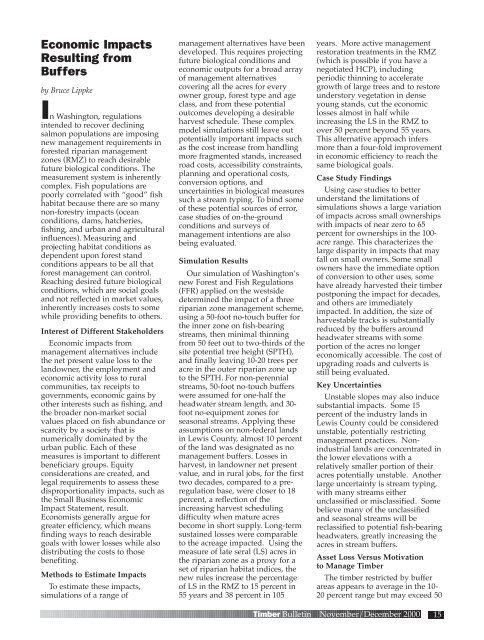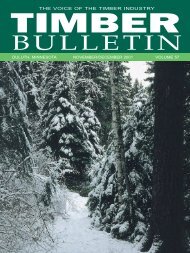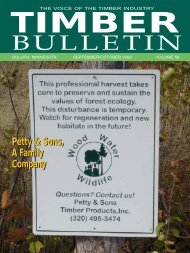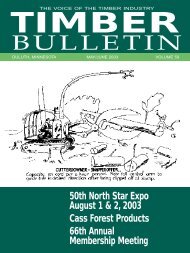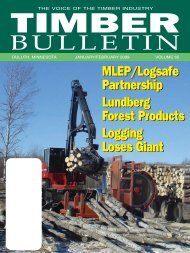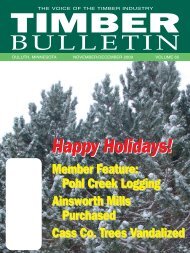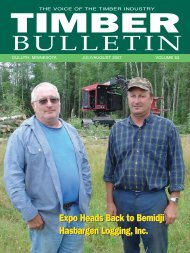Timber Bulletin Nov/Dec - Minnesota Forest Industries
Timber Bulletin Nov/Dec - Minnesota Forest Industries
Timber Bulletin Nov/Dec - Minnesota Forest Industries
Create successful ePaper yourself
Turn your PDF publications into a flip-book with our unique Google optimized e-Paper software.
Economic Impacts<br />
Resulting from<br />
Buffers<br />
by Bruce Lippke<br />
In Washington, regulations<br />
intended to recover declining<br />
salmon populations are imposing<br />
new management requirements in<br />
forested riparian management<br />
zones (RMZ) to reach desirable<br />
future biological conditions. The<br />
measurement system is inherently<br />
complex. Fish populations are<br />
poorly correlated with “good” fish<br />
habitat because there are so many<br />
non-forestry impacts (ocean<br />
conditions, dams, hatcheries,<br />
fishing, and urban and agricultural<br />
influences). Measuring and<br />
projecting habitat conditions as<br />
dependent upon forest stand<br />
conditions appears to be all that<br />
forest management can control.<br />
Reaching desired future biological<br />
conditions, which are social goals<br />
and not reflected in market values,<br />
inherently increases costs to some<br />
while providing benefits to others.<br />
Interest of Different Stakeholders<br />
Economic impacts from<br />
management alternatives include<br />
the net present value loss to the<br />
landowner, the employment and<br />
economic activity loss to rural<br />
communities, tax receipts to<br />
governments, economic gains by<br />
other interests such as fishing, and<br />
the broader non-market social<br />
values placed on fish abundance or<br />
scarcity by a society that is<br />
numerically dominated by the<br />
urban public. Each of these<br />
measures is important to different<br />
beneficiary groups. Equity<br />
considerations are created, and<br />
legal requirements to assess these<br />
disproportionality impacts, such as<br />
the Small Business Economic<br />
Impact Statement, result.<br />
Economists generally argue for<br />
greater efficiency, which means<br />
finding ways to reach desirable<br />
goals with lower losses while also<br />
distributing the costs to those<br />
benefiting.<br />
Methods to Estimate Impacts<br />
To estimate these impacts,<br />
simulations of a range of<br />
management alternatives have been<br />
developed. This requires projecting<br />
future biological conditions and<br />
economic outputs for a broad array<br />
of management alternatives<br />
covering all the acres for every<br />
owner group, forest type and age<br />
class, and from these potential<br />
outcomes developing a desirable<br />
harvest schedule. These complex<br />
model simulations still leave out<br />
potentially important impacts such<br />
as the cost increase from handling<br />
more fragmented stands, increased<br />
road costs, accessibility constraints,<br />
planning and operational costs,<br />
conversion options, and<br />
uncertainties in biological measures<br />
such a stream typing. To bind some<br />
of these potential sources of error,<br />
case studies of on-the-ground<br />
conditions and surveys of<br />
management intentions are also<br />
being evaluated.<br />
Simulation Results<br />
Our simulation of Washington’s<br />
new <strong>Forest</strong> and Fish Regulations<br />
(FFR) applied on the westside<br />
determined the impact of a three<br />
riparian zone management scheme,<br />
using a 50-foot no-touch buffer for<br />
the inner zone on fish-bearing<br />
streams, then minimal thinning<br />
from 50 feet out to two-thirds of the<br />
site potential tree height (SPTH),<br />
and finally leaving 10-20 trees per<br />
acre in the outer riparian zone up<br />
to the SPTH. For non-perennial<br />
streams, 50-foot no-touch buffers<br />
were assumed for one-half the<br />
headwater stream length, and 30-<br />
foot no-equipment zones for<br />
seasonal streams. Applying these<br />
assumptions on non-federal lands<br />
in Lewis County, almost 10 percent<br />
of the land was designated as no<br />
management buffers. Losses in<br />
harvest, in landowner net present<br />
value, and in rural jobs, for the first<br />
two decades, compared to a preregulation<br />
base, were closer to 18<br />
percent, a reflection of the<br />
increasing harvest scheduling<br />
difficulty when mature acres<br />
become in short supply. Long-term<br />
sustained losses were comparable<br />
to the acreage impacted. Using the<br />
measure of late seral (LS) acres in<br />
the riparian zone as a proxy for a<br />
set of riparian habitat indices, the<br />
new rules increase the percentage<br />
of LS in the RMZ to 15 percent in<br />
55 years and 38 percent in 105<br />
years. More active management<br />
restoration treatments in the RMZ<br />
(which is possible if you have a<br />
negotiated HCP), including<br />
periodic thinning to accelerate<br />
growth of large trees and to restore<br />
understory vegetation in dense<br />
young stands, cut the economic<br />
losses almost in half while<br />
increasing the LS in the RMZ to<br />
over 50 percent beyond 55 years.<br />
This alternative approach infers<br />
more than a four-fold improvement<br />
in economic efficiency to reach the<br />
same biological goals.<br />
Case Study Findings<br />
Using case studies to better<br />
understand the limitations of<br />
simulations shows a large variation<br />
of impacts across small ownerships<br />
with impacts of near zero to 65<br />
percent for ownerships in the 100-<br />
acre range. This characterizes the<br />
large disparity in impacts that may<br />
fall on small owners. Some small<br />
owners have the immediate option<br />
of conversion to other uses, some<br />
have already harvested their timber<br />
postponing the impact for decades,<br />
and others are immediately<br />
impacted. In addition, the size of<br />
harvestable tracks is substantially<br />
reduced by the buffers around<br />
headwater streams with some<br />
portion of the acres no longer<br />
economically accessible. The cost of<br />
upgrading roads and culverts is<br />
still being evaluated.<br />
Key Uncertainties<br />
Unstable slopes may also induce<br />
substantial impacts. Some 15<br />
percent of the industry lands in<br />
Lewis County could be considered<br />
unstable, potentially restricting<br />
management practices. Nonindustrial<br />
lands are concentrated in<br />
the lower elevations with a<br />
relatively smaller portion of their<br />
acres potentially unstable. Another<br />
large uncertainty is stream typing,<br />
with many streams either<br />
unclassified or misclassified. Some<br />
believe many of the unclassified<br />
and seasonal streams will be<br />
reclassified to potential fish-bearing<br />
headwaters, greatly increasing the<br />
acres in stream buffers.<br />
Asset Loss Versus Motivation<br />
to Manage <strong>Timber</strong><br />
The timber restricted by buffer<br />
areas appears to average in the 10-<br />
20 percent range but may exceed 50<br />
<strong>Timber</strong> <strong>Bulletin</strong> <strong>Nov</strong>ember/<strong>Dec</strong>ember 2000<br />
15


